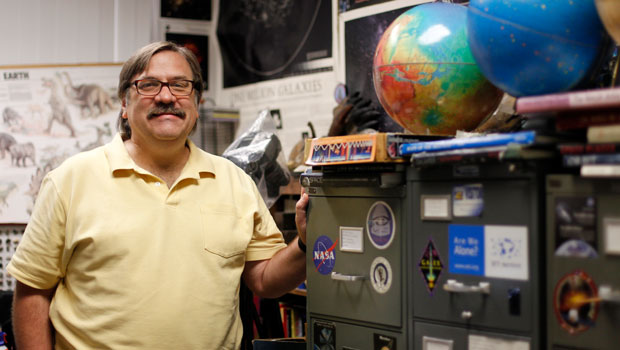Fresno State physics students will soon participate in international gravitational-wave research with the recent acceptance of Fresno State’s station at Sierra Remote Observatories into the Gravitational Wave-Electromagnetic follow-up program.
The program is part of the Laser Interferometer Gravitational-Wave Observatory (LIGO) Scientific Collaboration, which includes over 800 scientists from dozens of institutions and 13 countries worldwide. Founded in 1997, the collaboration seeks to make the first direct detection of gravitational waves — ripples in space created by extreme cosmic events that are predicted by Einstein’s theory of general relativity.
“This will explore the fundamental physics of gravity and will develop the emerging field of gravitational-wave science as a tool of astronomical discovery,” said Dr. Frederick Ringwald, professor in the Department of Physics.
Ringwald was notified by the LIGO program that the university’s observatory — one of nine that make up Sierra Remote Observatories located 47 miles northeast of Fresno near Shaver Lake — will join a network of visible-light observatories supporting the research that begins next year.
Founded in 1992, LIGO is an international resource for physics and astrophysics based in two widely separated sites within the United States — Hanford, Washington and Livingston, Louisiana. The sites are operated in unison as a single observatory. Another component of LIGO is the German-British GEO600 detector in Germany.
As one of the largest projects ever funded by the National Science Foundation at $365 million, LIGO is run by a consortium of the California Institute of Technology, the Massachusetts Institute of Technology and Louisiana State University. LIGO is also being run in collaboration with the independently funded detectors in Italy, the Netherlands, Brazil and Japan.
When the detectors find gravitational waves from the northern sky, Ringwald will be contacted to point the telescope in the direction of the waves using remote-control access to Fresno State’s station from his lab on campus. Ringwald and his physics students will investigate whether visible light can be detected.
“This will identify where exactly the gravitational waves come from,” Ringwald said. “Gravitational waves may come from supernovae (exploding stars), pulsars (dead cinders of stars), merging pairs of black holes or who knows what.
“This is huge for Fresno State because our students stand a very good chance of participating in cutting-edge science. Gravitational waves will open a new window on the universe.”
The Sierra Remote Observatories are dedicated to robotic and remote imaging and data acquisition. Built in 2007 on Bald Mountain, within the Sierra National Forest, they were established by members of the Central Valley Astronomers, Fresno’s astronomy club.
They are equipped with broad-band, fiber-optic internet, for fast access and download. This is rare in the Sierra Nevada Mountains, but is essential to running a remote observatory, Ringwald said.
At 4,610 feet, the site is above the fog and thermal inversion layer that hangs over the Central Valley. Live camera images are provided by ultra-low-light cameras that are passive but highly sensitive to starlight.
Fresno State’s station can be operated on-site, but is usually operated remotely.
(University Communications news assistants Jodi Raley contributed to this report.)





